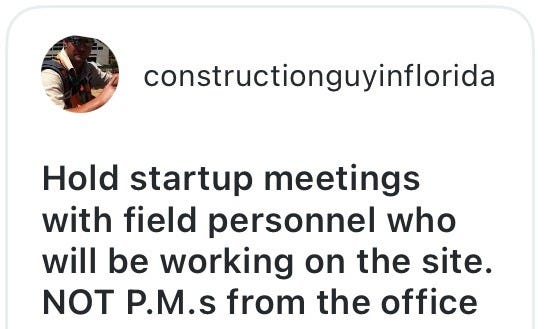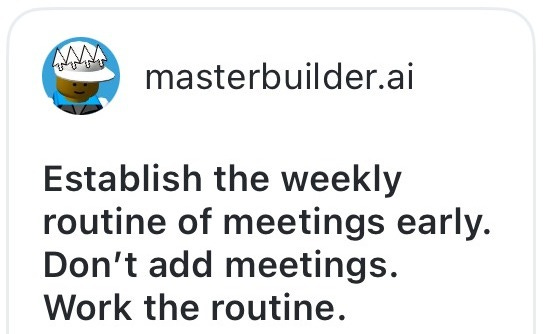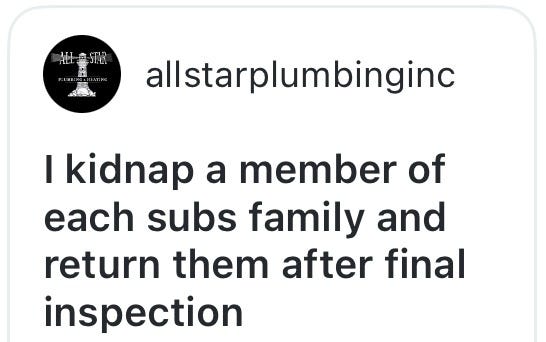Hey! Happy Sunday! Matt here.
Welcome to the Construction Curiosities newsletter!
Ok. So we’ve designed the project. Bought it out and negotiated the contracts. Now let’s look at the sprint that needs to happen as soon as the contract ink dries to ensure a successful jump start.
Lesssgo!
Summary
This week we will look at:
One Musing: First 4-Week Success Sprint
ConTech Corner: Get a Step Ahead in AI
One Meme: Copy/ Paste Spec Ignorance
The First 4-week Success Sprint
Many “project autopsies” trace the fatal infection back to one place: the awkward pause between contract signing and mobilization. Lose focus now and you’ll chase drama for the next 18 months. Lock it in, and the rest of the job feels like bowling with gutter guards.
Below is the zero-fluff, week-by-week roadmap I wish I’d had on my first big job. Steal it, tweak it, forward it to the PE who keeps asking what do we do next.
Now, a quick note… This roadmap was written to Contractors specifically (GCs & Subs).
BUT, if you are one of the Owner’s Reps or Architect/ Engineers reading this, think about how you can help in making sure the project starts off strong. Ultimately, if the contractor doesn’t have a successful project, neither do you.
Why the 30-Day Window Matters
Two clocks start ticking: liquidated-damages on one, “administrative debt” on the other. Pay the paperwork bill now or pay change-order interest later.
Cheap moves, huge impact: the opportunity curve is still at the bargain-basement end.
Trust snowballs: early wins with the Owner, AHJ, and subs compound faster than your 401(k).
We should all know what liquidated damages are, but what is “administrative debt?”
Administrative debt is the stack of boring‐but‐mandatory paperwork you ignore in Month 1 that comes back to bite you in Month 12.
Think of it like technical debt in software: every undocumented decision, missing form, or half-baked log collects “interest.” Only here the interest shows up as:
Late pay apps because the Schedule of Values never matched the cost codes
Change‐order fights over scope inclusion/ exclusions that you forgot to memorialize
Submittal limbo that chokes long-lead items
Permit delays because there wasn’t an intentional plan to align with the AHJ
Skip the admin stuff now, and you’ll pay later with delays, claim prep hours, and enough email CCs to crash Outlook.
So front-load the paperwork, close the loops, and keep the debt collectors off your jobsite. Simple?
Must-Do vs. Should-Do
When you are looking at kicking off a new project there are things that you Must-Do and things you Should-do.
The “Must-Do” things are what your Contract says you have to do. Duh. Things like submit bonds, insurance, baseline CPM schedule, Submittal Logs, & Draft Schedule of Values.
The “Should-Do” things are best practices to get your team off on the right foot and with a competitive edge. These are things like setting up your risk register, digital closeout vault, lead-time/ procurement tracker, & neighbor relations game-plan.
Contract Must-Do’s
The following list are typical items found in the standard AIA A101/ A201 Contracts but you need to RTFC (Read The F’n Contract) and make a project specific list.
Day 1-10: Deliver performance & payment bonds and insurance certs (triggers Notice to Proceed)
Day 1-14: Submit proposed subcontractor / supplier list (Owner has 14 days to object)
Day 1-14: Draft and deliver baseline CPM schedule.
Day 1-14: Create and submit the Submittal schedule for approval. Understand what the A/E actually wants to review so they don’t get bogged down with unwanted information that will slow down the whole approval process.
Day 1-14: Issue initial Schedule of Values (needed before first pay app). The quicker you can get the Owner to agree to the SOV the quicker you can start invoicing.
Start process Week 1: File for / secure all building and agency permits.
First Month: Provide first Application for Payment at least 10 days before pay date (A201 §9.3.1). Walk through the pay app with the Owner/ Owner’s Rep/ All Reviewers.
4 weeks before mobilization: Prepare initial site-specific Safety Plan (A201 §10.2)
Best Practice Should-Do’s
The following list is obviously FAR from all-inclusive, but some best practices to give your team a jump start out of the gates to help ensure a successful project.
RTFC and build out your project-specific First 30-day Sprint Plan.
Week 1: Estimator-to-PM Handoff deep-dive - Surfacing bid assumptions prevent scope gaps or scope creep.
Week 1: Set up your standard project file folder structure (including Closeouts!) - When you start thinking with the end in mind, it’ll save you months at turnover and get that retention released much sooner.
Week 1: Launch a Rolling Buy-Out Tracker with lead-time heat map - Helps your team know what is hot for submittals and lets nothing slip through the cracks along the way.
Week 2: Create a Site Logistics Sketch for owner approval (cranes, lay-down, deliveries) - Catch space conflicts early and start the transparent communication with the owner.
Week 2: Open a live Risk Register + Opportunity Log - Turns unknowns into tracked action items
Week 2: Roll out a Neighbor Relations plan (contacts, goodwill budget, hotline) - Keeps complaints from shutting the gates
Week 2-3: Hold a Safety & Quality Pre-Mortem Workshop with key subs - Aligns cultures before day-one finger-pointing. Talk about: if this project goes wrong, what will be the cause? Put identified issues on the Risk Register, and work to resolve.
Week 2-3: Capture 360° / drone baseline photos of existing conditions - Evidence for future change-order disputes. (This likely might be a contract requirement too)
Week 2-3: Plot a Cash-Flow Forecast - helps the accounting folks plan
Week 3: Host Kickoff Meeting 2.0 (interactive, action-oriented) - Converts stakeholders into do-ers. (More on this in a future Newsletter Edition!)
Week 3: Run first BIM / clash detection - Start resolving issues ASAP.
Week 3: Push a “Top-10 Submittal Sprint” through approval - Get your long-lead items in fabrication now
Week 4: Finalize the Mobilization Checklist (trailers, signage, utilities) - Make sure when Boots hit the ground, those Boots hit the ground running.
Some Tips from the Socials
I asked on the Construction Yeti Instagram Page: “What are your Project kickoff super hacks to start a project off strong?” And I promised to feature the best in this Newsletter. Here ya’ll go:
That’s just jokes obviously (hopefully 😬). But sometimes long, drawn-out retention can be just as painful. Have the conversation early with ALL parties on what it takes to release and/ or reduce retention.
Or when all else fails:
ConTech Corner
Not specifically ConTech, but here’s some AI goodness to make you a better PM.
One Meme
And on this day, the Project Engineer learned how specs and drawing details get copy/ pasted. 🫠
Construction Curiosities is a reader-supported Newsletter. Please consider upgrading your subscription to help support the work we are doing. With your support, we have more big things planned and in the works.
















Pleases take a look at https://wasteguardinnovations.com